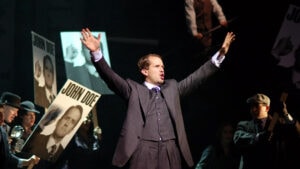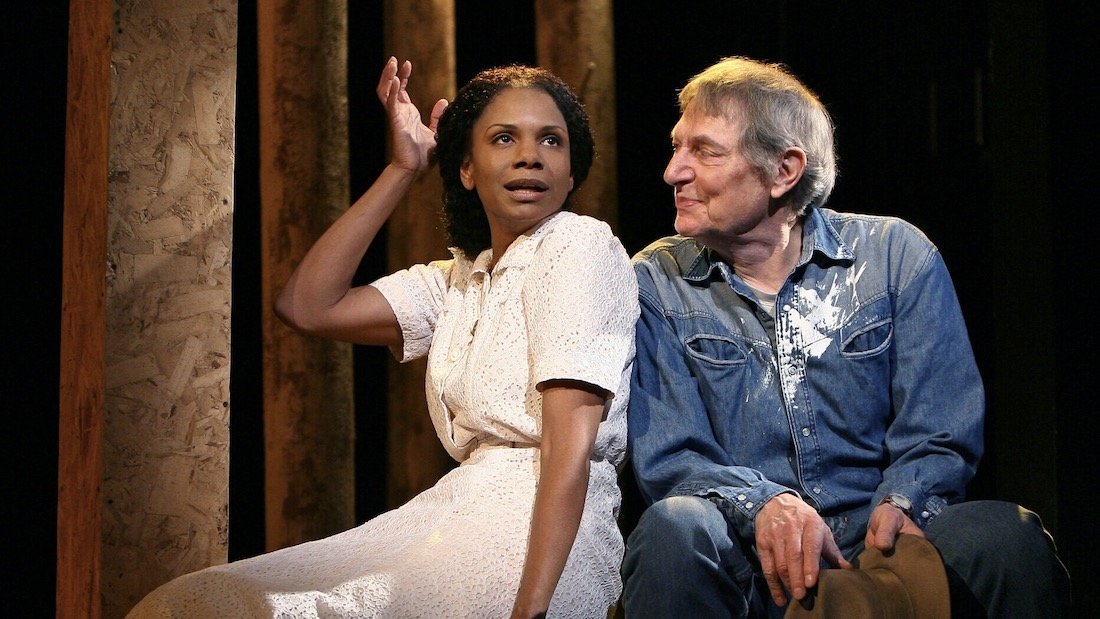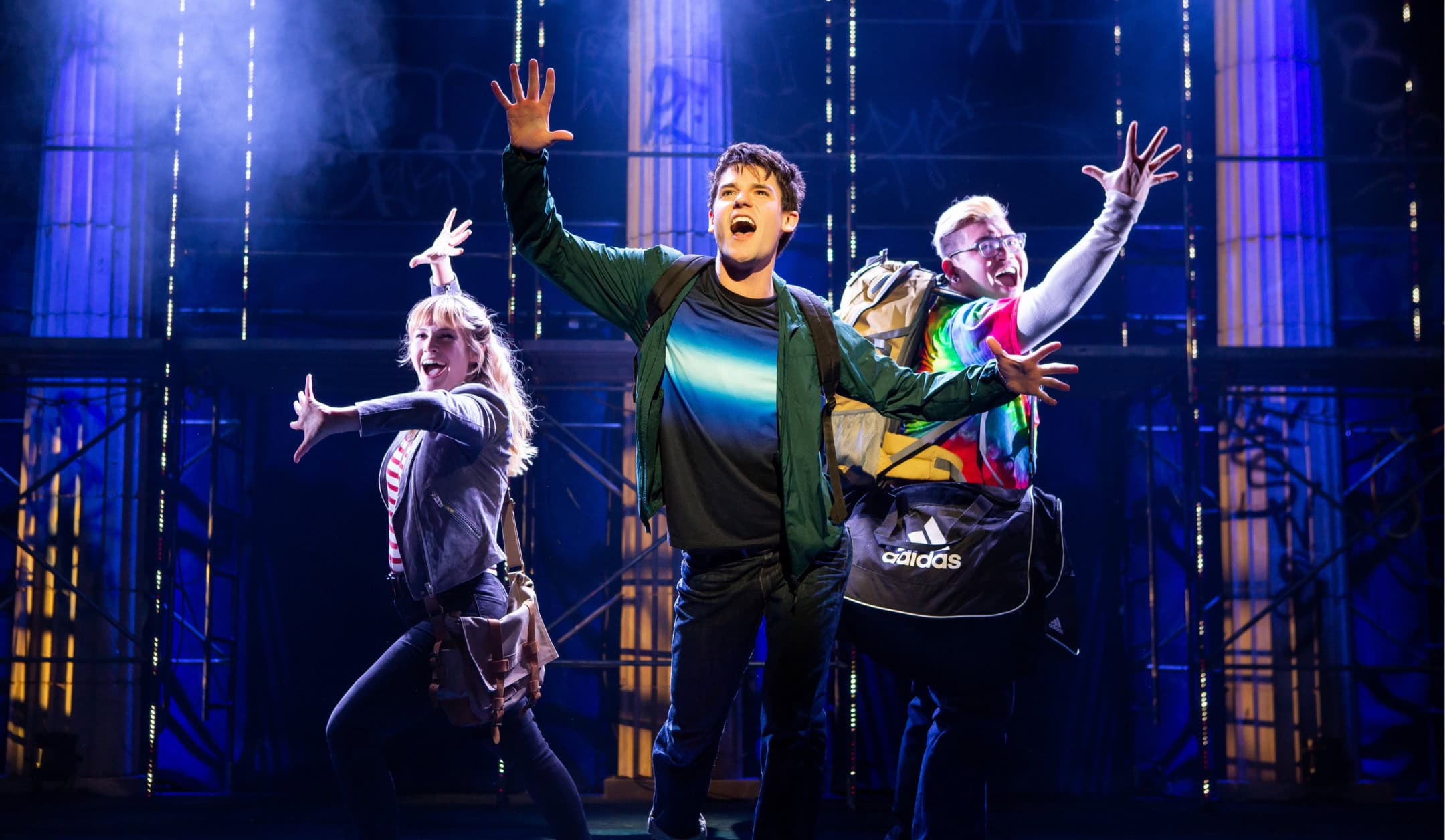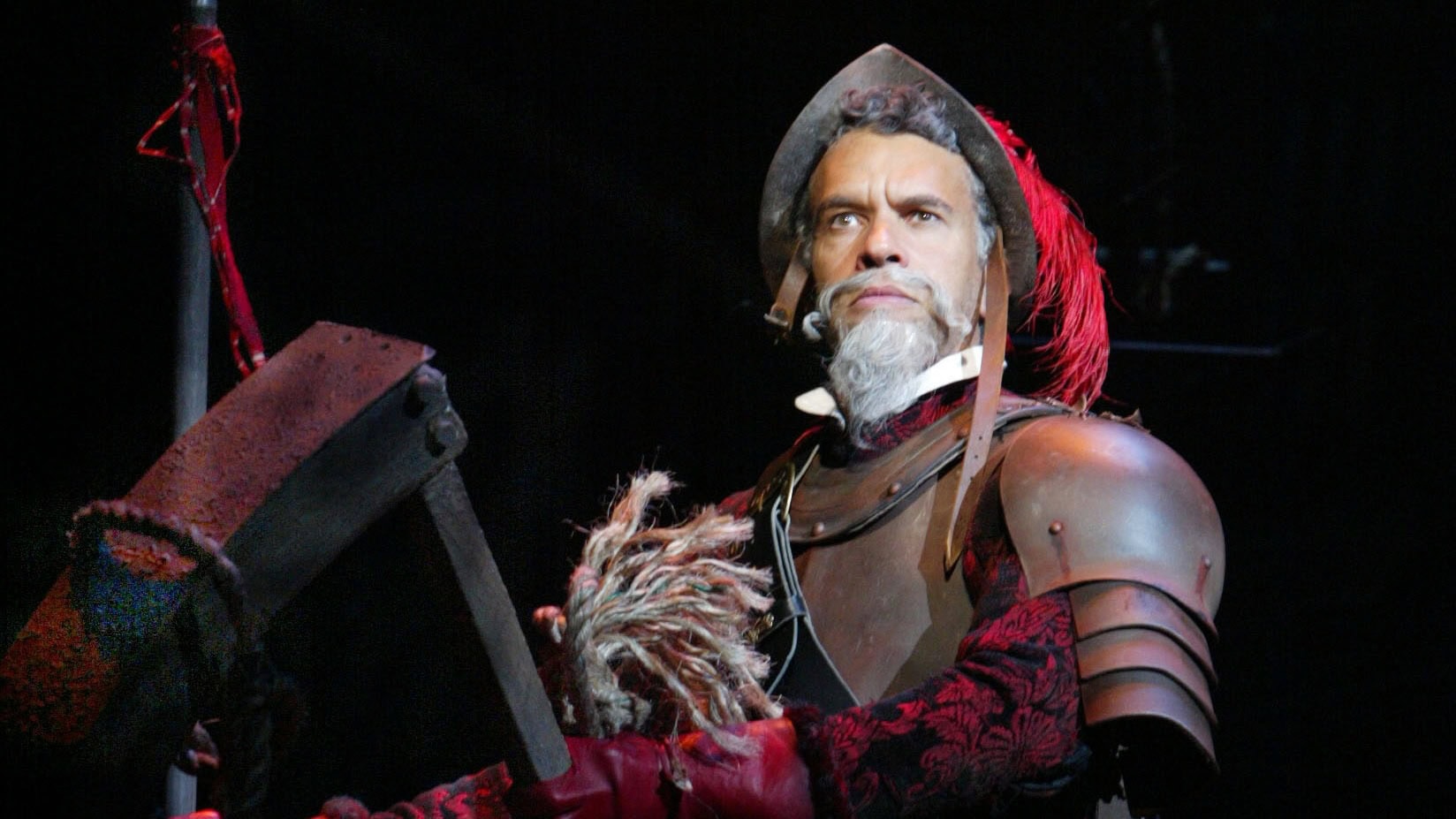
The musical Meet John Doe, based on Frank Capra’s beloved film, is a hopeful new Depression-era show about media, politics and the American Dream, featuring a powerful score, an epic story, razor-sharp dialogue and an iconic female lead. We sat down with the musical’s co-creators, Andrew Gerle (music and book) and Eddie Sugarman (lyrics and book), to discuss the show’s gestation, its powerful themes, and its increasing relevance in our current climate.
For those who don’t know Meet John Doe, tell us a little about source material and the plot.
Andrew Gerle: Meet John Doe was a 1941 movie by the great American director Frank Capra (It’s a Wonderful Life) starring Barbara Stanwyck and Gary Cooper. It has everything you want from these three: crackling dialogue, real heart, and a powerful social message. It centers on a smart (and often smart-aleck) reporter, Ann Mitchell, who is fired from her newspaper because the new owner, oil tycoon D.B. Norton, says he wants columns with “fireworks.” As a parting prank, she writes a letter to her own column from a “John Doe,” who is planning to jump off the Brooklyn Bridge on Christmas Eve to “protest the state of society.” She never expects it to go to print –
Eddie Sugarman: – but of course it does, and “John” becomes a huge sensation. Ann basically blackmails her way back into her job, and finds an out-of-work ballplayer, John Willoughby, to play him, first just as the column’s photo, but then actually giving speeches as his popularity takes off around the country. A grassroots movement of communities springs up based on his ideas, people coming together to help each other in the heart of the Depression. All these people across the country catch Norton’s attention, who pressures Ann to have John endorse him as he makes a bid for the White House.
AG: When they refuse to betray the genuine movement that they inadvertently created, things get pretty dark pretty quick, and Ann and John have to decide how far they’ll go to protect what started as a lie, but has turned into something real and good.
What first drew you to this project?
ES: I had worked for a while on an adaptation of another Cooper/Stanwyck film (Ball of Fire) without getting the underlying rights: big mistake! A notable Broadway producer optioned the rights to that film and I was on the outs. So after getting burned, I spent a few weeks researching at the Lincoln Center Performing Arts Library, generated a list of films that had fallen into the public domain, and started watching them. When I first saw Meet John Doe, I was drawn to the sweet-and-sour combination of John and Ann: this “Capra corn” idealist caught up in a cynical scam with a brilliant opportunist. I asked Andrew to watch it, and I think I remember he responded strongly to some other themes.
AG: Yeah, at that time I hadn’t written a show with a real social message, and I loved what the film had to say about the promise of America, the social contract that is (or should be) at its core. And of course, I wanted to take a crack at ’30s and ’40s-style big band music!
In your liner notes for the show’s original cast recording, you call Frank Capra’s film “important if flawed.” What were the “flaws” in the film, and how did you address them in your adaptation?
AG: Some of the things we wanted to change were just tonal issues, gags that haven’t aged well, etc. But mostly it was the ending, which even Capra had struggled with, writing and shooting multiple versions but never really finding a satisfying solution to the problem: does the real John actually jump off the bridge like the fictional one promised? At the time, Capra and his writers felt audiences wouldn’t stand for it, and they settled on a corny ending that lets him live, but that we felt seriously undercuts the message of both the movement and the film. After a LOT of back and forth, we knew we had to have John finish what Ann started (to her horror), and give John a tragic hero’s arc. It also gives Ann, who started out as cynical as anyone, the opportunity to transform herself into an idealist, a kind of Jackie Kennedy figure. We think (and critics agreed, thankfully) that it’s a more honest and emotionally affecting ending for today’s audiences.
“I think we are drawn to these stories of the struggle between the rich and powerful and the common folk because we are always living in that story. Meet John Doe puts us right in the middle of that fight.”
You’ve written a fantastic leading lady role in Ann Mitchell. In the script, you call her “a tough cookie” and “a nervy, brassy broad.” Ann makes some morally questionable choices in the show, but somehow, she remains appealing to the audience. How did you walk that fine line?
AG: Writing Ann was a terrific lesson why flawed characters are so compelling. She’s funny and sassy and smart, but makes some pretty awful decisions (for understandable reasons, but still…). What’s great is it really gets the audience involved – the whole time, you’re thinking, “No, don’t do that!” but still rooting for the moment she’ll learn her lesson and fix all the trouble she’s getting into. We made sure all her songs get you on her side, alternately jazzy and emotional (she has a sweet relationship with her deceased father) and you end up just wanting to be her friend, if only so you could give her some advice. We also learned her age is important – she has to be old enough to have the confidence to pull off what she does, but not so old that she really ought to know better. Late 20s-early 30s is the sweet spot.
The show begins with a wealthy new owner firing most of a newspaper’s staff. (“We will all need to tighten our belts in the interest of profitability,” he says.) Later, the worlds of journalism and politics intersect in distressing but familiar ways. How do you think this story remains relevant today, particularly with respect to politics and media?
ES: There’s a lot in Meet John Doe that feels familiar: mass layoffs by the ultra-wealthy, feelings of national despair, and attention-getting influencers. Don’t we all really just want a John Doe to believe in, to remind us how to act, and maybe how to vote?
When people are scared and desperate, they long for simple, meaningful answers in a complex, unjust world, and boy, is that an opportunity for the powerful and unscrupulous to take advantage. And when the powerful own media outlets, they can influence huge numbers of people. We see it today with podcasts, TikToks, and newspapers, and it’s always existed in some form. I think we are drawn to these stories of the struggle between the rich and powerful and the common folk because we are always living in that story. Meet John Doe puts us right in the middle of that fight with a reporter who both creates the country’s greatest con AND tells the biggest truth. That’s the delicious contradiction of this show.
“We hope the show can be a reminder that a country this big and diverse depends on everyone looking out for each other, even in the smallest of ways.”
Despite addressing injustice, corruption and misinformation, Meet John Doe carries a clear message of hope.
AG: The show is set during the Depression, when times were terrible for so many, and the movie came out in 1941, when the world was literally on fire. For Capra, the message was always “We’re all in this together,” and in our show, it’s the ensemble that delivers that backbone of hope. There’s a totally a cappella number called “Thank You” at the top of Act II where we hear about the small acts of kindness he’s inspired in their community, and the extended “Bigger Than Baseball” number where we see that effect spreading across the country. It affects Ann deeply – she finally sees the better nature of people that John always knew was there, and realizes that words aren’t just a way to sell papers, they can change the world for the better. We hope the show can be a reminder that a country this big and diverse depends on everyone looking out for each other, even in the smallest of ways.
The musical’s score is a wonderful blend of 1930s swing and contemporary musical theatre. How did you determine the sound of the show?
AG: I had a sound in my head for the show from the beginning, a combination of classic musical theater with a big band swing. So Ann would have a New York, Woody Herman/Rodgers & Hart kick, while John is more Midwestern, a little Jones & Schmidt. But Eddie found so many more distinct and distinctly American colors for characters like Norton (a Texas twang), Connell (older generation, WWI sincerity), and the ensemble (simple, almost folk-like), that it pushed me to write a more diverse score, which I’m really proud of. It feels like what I imagine America in the ’30s felt like.
The musical is written for six principal actors, plus an ensemble, and the score is arranged for five musicians. It can be done on a fairly small budget, but it can also be expanded into a larger production. How do you tell this story with just five musicians?
AG: Actually, the original orchestration for the Ford’s Theatre production was (and I still can’t believe I get to say this) by Jonathan Tunick, the greatest living Broadway orchestrator and my musical hero for as long as I can remember. It was for 10 pieces, based on a 4-piece orchestration I had done for our run at the New York Musical Theatre Festival. For a smaller production in Chicago, I reduced his work down to 5 pieces, which is what is heard on our studio cast album.

2007 Ford’s Theatre production of Meet John Doe (Mark Ramont)
At the end of the first act, John Doe delivers a beautifully powerful speech about community. “You can’t be a stranger to any guy that’s on your own team,” he says. “So tear down the fence that separates you… and you’ll tear down a lot of hates and prejudices.” What, to you, does the show say about community?
ES: I love that quote, too. What I take away from Meet John Doe is that community is the answer to our biggest problems. In communities, we can weather the storms of life. You got hate? Corruption? Tyranny? They don’t stand a chance against loving thy neighbor. Tribalism separates us, but community connects us powerfully. Even the biggest lie you’ve ever heard can’t break it. That’s what I get from this story.
Is there a particular moment in the show that holds special resonance for you? Why?
AG: I obviously love the big band numbers for Ann – that style is partly what drew me to the film in the first place, and they are definitely a lot of fun. But for me, the moment that always gets me is “Thank You,” the a cappella number for the townspeople. Hearing people who are not showy, who don’t wear their emotions on their sleeves like most musical theatre characters, step forward and try to put words to their gratitude for the little bit of hope John has offered them, when one says, “Here are some brownies I just made that I wanted to bring you, even though they’re not very good,” it’s so human and real and I find it very moving. Everyday people just trying to get by and show a little kindness.
ES: “Who The Hell (Forgot to Tell My Heart)” is my favorite song in the show. We’ve been waiting for Ann and John to get together for a full act and a half and this is the payoff. Much of the show has a lot of plot going on, then, finally, this moment arrives where our two leads are all alone and everything boils over. I find the music irresistible, and I’m proud of the lyrics which have, I think, a nice Dorothy Parker feel to them.
“Audiences really will laugh, cry, and come away feeling hope that they can make a difference in the country.”
Several songs from the show have become extremely popular as audition material. Two in particular, “I’m Your Man” and “He Threw Me,” top the list of most popular audition songs every year. How does it feel to have contributed to the Great American Songbook?
ES: These two songs both took a while for us to find but once we got there, they felt like hits. Our Anns always dug deep into these numbers and you could feel the energy pour over the footlights into the audience. We knew that something had happened with “I’m Your Man” when it started showing up at auditions. One year, Andrew was accompanying for one of the big summer stock auditions and he started texting me: “Six ‘I’m Your Man’s so far…” “8…” “11…” And that felt great!
AG: There are also a lot of YouTube videos of terrific actors singing those songs, and nothing makes me happier than seeing so many people find their own takes on Ann and falling in love with her nerve and humor just like we did.
For theatres considering Meet John Doe for their upcoming season, let’s help with their pitch! Why should they produce Meet John Doe?
ES: Theatres should produce Meet John Doe to bring hope, humor, and deep emotion to their audiences. It has a unique combination of razor-sharp wit, fast-paced period action, and a powerful dramatic story that’s as relevant today as it was in 1941. A hell of a leading lady anchors a cast of juicy leads and the score is lush, sophisticated and unforgettable. Your audiences really will laugh, cry, and come away feeling hope that they can make a difference in the country.
To learn more about licensing Meet John Doe, visit Concord Theatricals.

Plays that Inspired Musicals

QUIZ: Which Character from The Lightning Thief Are You?

